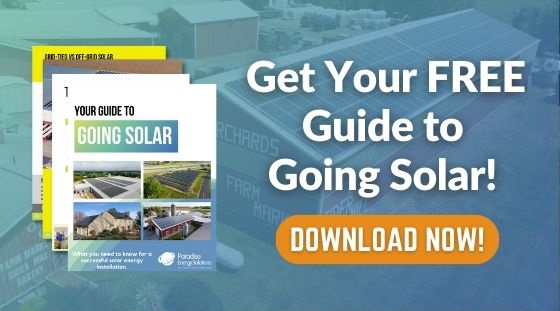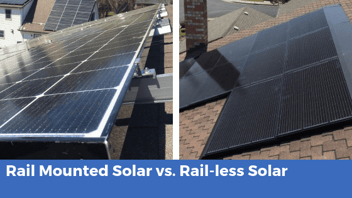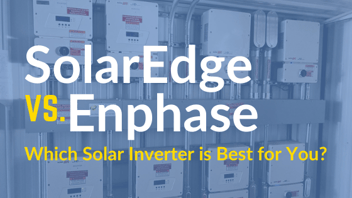Maximize Solar Energy: How to Calculate Solar Production

Switching the power in your home or business to solar can be an exciting time. One of the most important things you’ll see when receiving estimates is the expected production of the proposed system. This number will tell you how much free electricity your solar panels will produce.
Calculating your solar production is more than multiplying the panels’ baseline production by the number of panels included with your system. Many other factors can come between the sun and your solar panels.
Properly calculating production for a PV solar energy system is critical to determining how many panels you will need and the economic value of switching to solar power. No one wants to be oversold, underdelivered, or paid for more than they need.
When looking at production estimates, keep in mind that it’s not out of the realm of possibility that the total sunlight in one location could vary by 10% from year to year. Still, taking the time to calculate production as closely as possible can give you the best idea of what you can expect from switching to solar.
How to Calculate Solar Production
Companies can calculate solar production by taking the highest level of productivity and removing estimated losses based on product degradation and environmental factors.
Despite these losses, solar can still be a very profitable investment with a front-loaded payback thanks to tax incentives and grants. Making the change can also produce your own free electricity for decades.
Measured Sunshine
To find the production of a solar system, a solar installer will start with the solar panels and the amount of sunshine that hits a location (which will vary based on where you live and the weather patterns in your area). Then, they’ll calculate the losses for your specific site and system to come up with a good picture of what your system can do.
Panel Rating
Solar panel manufacturers conduct rigorous testing to paint an accurate picture of their solar panels’ output. To control for variables and give a reliable baseline, these tests are conducted under standard testing conditions (STC), where temperature and irradiance are controlled.
Panels are rated in watts, but they also have a power tolerance percentage. If this percentage is negative, the panel could produce less than it is rated for. For example, a 300-watt panel with a power tolerance of -3% could actually produce as little as 291 watts at STC. All panels used by Paradise Energy have a positive power tolerance, so they will produce their rated amount or more at STC.
The solar panel’s predicted output is a great way to estimate power production, but it isn’t always accurate. The panel’s power rating may vary slightly. However, today’s solar panels produce at least their rated output, if not more.
Light-Induced Degradation (LID)
Degradation is a normal, unavoidable, and slightly frustrating part of solar panels. Every household appliance loses efficiency as it slowly ages past its prime lifespan.
LID is a loss of performance arising in the first hours of exposure to sunlight and happens all at once when the system is installed and turned on. In that short time, your panels can degrade by 1–3%. However, after those initial few hours, your panel degradation slows significantly to the manufacturer-specified degradation rate, which is protected under warranty.
Paradise Energy uses industry-standard 1.5% LID losses for performance calculations.
Following the initial LID, you can expect your solar panels to degrade less than 1% yearly. A warranty from the solar panel manufacturer backs the degradation rate. For most solar panels, you can expect a 90% production guarantee for the first ten years and then an 80% guarantee by year 25 or 30.

Mismatch
If your solar system uses a string inverter as opposed to micro-inverters or optimizers, there will be a small reduction in energy produced because of the slight variations between the solar panels themselves. Even the same solar panels manufactured by the same company won’t be exactly the same due to slight variations in the electrical parameters.
When one panel is producing more or less than the other panels in the system, this could lead to the loss of energy. Although panels are rated for the same voltage and current, they may experience a small amount of mismatch. Module Level Power Electronics (MLPE) solutions can resolve this issue.
Paradise Energy uses the industry standard 2% losses for string inverters and 0% losses for inverters using MLPE solutions.
Environmental Impacts on Solar Production
Irradiance losses are caused by factors that inhibit the sun’s energy from reaching your solar panels. They include things like the tilt of your panels, shading (whether from the surrounding terrain, trees, or buildings), soiling, snow, and incident angle modifier.
Location
Weather station data is the starting point for calculating production, but it is also the biggest variable. Even though the sun can be measured, weather cannot be controlled, so there may be variations in one location from one year to the next. When choosing a weather station, it is important to consider the number of years that data has been collected from that site and its proximity to the site of the solar system.
Tilt and Orientation
Typically, the closer the array tilt is to the latitude for a particular location, the greater the solar production. However, slight variations in tilt will only have minimal effects on production.
Solar panels produce electricity by drawing energy from the sun. The less sun that reaches the panels, the less electricity they’ll generate. So optimizing your production, you’ll want to install your solar panels at an angle and in the direction where they get the most consistent sunlight.
Solar panels will generate less electricity when the sunlight enters at an angle, and more when the sunlight hits the panel perpendicularly. This is known as the incident angle modifier. The angle of the tilt will vary with the latitude in which your system is located. As a general rule of thumb, the closer the tilt of the solar array is to the location's latitude, the more the array will produce.
Orientation
In addition to the tilt is the orientation of the panels. You’ll want the panels to face as close to true south as possible to extend their exposure to sunlight throughout the day.
An orientation of 180° (true south) typically provides the optimal production for a solar array. An orientation of east or west can reduce production by 15%, although that can vary significantly because of the array tilt. For systems that face east, west, or north, it is more advantageous to have a lower tilt.
At the equator, you’d want to install your solar panels completely flat. In the Northeastern United States, the ideal tilt ranges from about 37° (central Virginia) to 44° (Northern New York). Irradiance losses come into play, however, when your installer can’t install solar panels at this angle.
While both the tilt and orientation play a role in how much energy your solar system produces, your property may not allow you to install a system in the optimal manner. If you opt for a roof-mount solar system, your panels will probably be installed at the tilt of your roof. And depending on the orientation of your building and roof space, the panels may need to be oriented to the west or the east.
A ground-mount solar system is an option for those with a roof that isn’t great for solar. Although the cost of a ground-mount will be slightly higher, they can be positioned for the best solar production, in most cases.
If you can’t meet these factors perfectly, installing solar can still be beneficial. The loss in production for both factors is relatively small in the grand scheme of your system and can be made up with the addition of a few extra solar panels.
Shade
Shade is an enemy of any solar panel. Calculating the loss in production due to shade can be challenging since it depends on the time of the day/year in which the array is shaded, as well as what module and inverter technologies are used.
Anything that casts a shadow on your solar panels stands between you and free electricity. If possible, shade should be avoided, either by finding a sunnier spot to install the panels or removing the source of shade.
Depending on the terrain surrounding your building, shade can also come from nearby hills, mountains, or plateaus. This is known as horizon shade. For example, if you live at the foot of a mountain, the sun will dip below the mountain/horizon far earlier in the day than if you live in a very flat area. This reduces the hours of the day your solar system is exposed to sunlight.
Soiling
Like shade, the more that comes between the face of your solar panels and the sun, the less electricity the system will produce. This includes dust and dirt that could accumulate on the solar panels. It is common for roof mounted solar panels in humid climates to collect leaves in the fall or for moss to grow over time.
In most areas of the country, it rains frequently enough to keep dust and dirt from accumulating heavily and having a significant impact on the system. However dryer, dustier climates are more likely to have soiling create a measurable impact on your system.
While the impact is small, it’s still a factor that should be considered to get the most accurate solar production estimate.
Snow
When it snows, accumulation can block the sunlight and inhibit your solar system’s production. Solar panels allow for snow to quickly melt and slide off the panels, shortening the time they stay covered.
Depending on what area of the country you live in, this may or may not have a measurable impact on the production of your system, but it’s something solar installers should account for.
Losing production due to snow is minimal. Cleaning snow off solar panels can be a danger to you, your system, and could result in the loss of your warranty.
Paradise Energy Solutions does not recommend clearing snow off your system yourself. With our Triple Ten Guarantee, any production loss caused by snow would be covered so there is no risk in letting the snow clear itself.
System Losses of Solar Production
Solar panels are connected in strings. In a string, each panel is connected to another through wiring. There is some loss as the energy travels through the wiring in the string because of the resistance within the circuit.
AC/DC Conversion Loss
DC (Direct Current) losses are electrical losses that happen after the solar panels harness sunlight but before the energy is transmitted to the inverters. AC (Alternating Current) losses happen once the DC power goes to the inverter and before it is consumed in your building. Just like the electricity lost on the DC side of your system, you may lose some production on the AC side because of resistance in the circuit caused by wiring.
Your solar panels produce DC electricity, but your building most likely runs on AC. It’s the inverter's job to convert the DC power from your panels to the AC power your building needs.
Inverters do this with great efficiency, but not 100%, meaning some power is lost during the conversion process. Depending on the inverter brand, type, and model, you can expect your inverters to run at about 96-99% efficiency.
Inverter Efficiency and Clipping
Sometimes, your solar panels produce a little more energy than your inverters can handle. This is called solar clipping. Clipping refers to the power that is produced by the solar modules that is greater than the capacity of the inverter to harvest.
Clipping is common on cool sunny days when the system is producing at peak capacity. Complex software is required to properly account for clipping over time. As solar panel prices continue to fall, more and more systems are designed for higher percentages of clipping to properly utilize the inverters and other equipment installed for the solar array.
In order to keep your system running optimally, the inverter will trim the output of electricity to the amount that it can safely convert. When this happens, you’ll lose some of the electricity generated by your panels.
Inverter specification sheets show 2 efficiency ratings, max efficiency and California Energy Commission (CEC) efficiency. Max efficiency is the maximum efficiency in which the inverter can convert power from Direct Current (DC) to Alternating Current (AC), while CEC efficiency is more of an average efficiency.
Paradise Energy uses complex software to calculate the inverter efficiency based on the sunlight and electrical characteristics of the panels connected to each inverter. This is significantly more accurate than using the CEC efficiency, as efficiency can vary depending on DC voltage and inverter utilization percentage.
Resistance
With solar systems, where there’s resistance, there is often power loss. Such is the case in the wiring and soldering connected inside the solar panels. These connections reduce how much electricity solar panels can produce by adding electrical resistance to the circuit.
Due to heat and voltage drop, even a system with properly sized wires and connections will lose a small percentage of production in moving power from the panels to the system owner’s utility meter.
Other Factors to Calculate Solar Production
When collecting estimates, many solar companies will include an “Other Losses” category. It’s a catch-all for items not accounted for above. The company doing your solar estimate will go with a value they feel comfortably reflects the variability of your system’s production.
Availability
Your solar system will experience productivity loss whenever the system needs to be shut off. If your solar system is connected to the utility grid, code requires it to shut down when the power goes off for the safety of utility workers. If your system needs maintenance, it will also have to be turned off, meaning it won’t be producing energy.
Most systems will experience some downtime when the system is not producing at all or is only producing at partial capacity. Downtime can include power outages, as well as panel and inverter failures.
What is Left Over When Calculating Solar Production?
Despite all these factors that eat away at your solar system’s production, it’s still a remarkably beneficial and efficient technology that can have a real positive financial impact on your home, farm, or business.
These factors will all be included in your solar proposal’s production estimate, meaning what you see is (just about) what you’ll get.
And if you choose to go solar with Paradise Energy, you’ll get exactly what you see, thanks to our unique Triple Ten Guarantee. Included in this is our production guarantee, which states that if your solar system doesn’t produce what we estimate it will, we’ll pay you the difference.
At Paradise Energy Solutions, we take production calculations seriously and understand our customers depend on accurate production estimates over the 30+ year life of the system.
Contact us today for a no-obligation custom quote to see how solar can help you save more of your hard-earned money.



